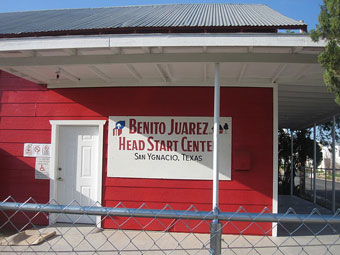Pre-K prerequisite
TO: The President-Elect
FROM: Robert Pianta
SUBJECT: Equalizing educational opportunity
The time has come to ensure that every poor preschooler in the United States is enrolled for two years of the best educational opportunity the public can provide. Anything short of this will fail to realize the promise of early education as an equalizer in American society.
Public education is one of America’s drivers of social and economic mobility, an investment in opportunity for all citizens. Although the authority to provide public education rests in the states, a federal role can emerge through policies that address civil rights or through investments that supplement states’ goals. After eight years of aggressive federal efforts to influence the public education system (e.g., Common Core, teacher evaluation), K-12 education is effectively off limits to the new president. However, you can make a bold move to optimize and strengthen federal investments in need of further reform and align them with state systems in ways that can really make a difference for children.
Public education is one of America’s drivers of social and economic mobility.
Most states are feeling pressure to serve 3-year-olds as the public awareness of the value of early education increases. States want to provide two-year, full-time preschool for 3- and 4-year-olds but don’t have the funds. Form early learning partnerships with states to produce positive results for generations; simplify and focus a complex part of the federal bureaucracy.
Your opportunity goal in the first year can be to ensure that every poor child is enrolled for two full years in an educationally effective preschool program starting at age 3.
History, context, and the current state of play
The public regularly endorses investments in early education; opinion polls show that a majority believes that the education of young children, particularly poor children, pays dividends. A majority of governors have expanded their state-run prekindergarten programs for 4-year-olds; now 42 states offer public prekindergarten. The science shows that some state-run, scaled-up programs for 4-year-olds can close the achievement gap on state-standards tests in elementary school by between 30 percent and 80 percent, but these offerings typically run nine months a year, meaning the dose children receive is simply too low. Head Start, the federally run program for poor 3- and 4-year-olds (many from even lower income levels than enrolled in state programs), has shown only modest impacts on achievement in school and benefits for children’s adjustment, health, and lowered special education services. The federal government also provides subsidies to poor families seeking child care, a portion of which covers costs for 3- and 4-year-olds to attend a wide assortment of generally low-quality placements. In aggregate, the country invests almost $30 billion in the education and care of 3- and 4-year-olds from low-income families (combining federal and state funds), resources that flow through convoluted pathways, funding disparate programs that are not well integrated and not sufficiently intensive to close learning gaps. Some state- and city-run preschool programs braid and blend funds with local Head Start grantees and come closer to using an all-funds approach to provide a sufficient dose of integrated and effective programming for poor 3- and 4-year-olds; these programs are models for this policy initiative.

Remember the problem here is that the programs now being delivered through federal support need strengthening in terms of impacts on school performance and child development; direct federal oversight of preschool is inefficient; and state and local programs mostly serve 4-year-olds for only nine months of the year. You can seize public support for early education and drive an equity agenda to serve young poor children with programming that can close achievement gaps. You will face opposition from constituencies on the left who own the antipoverty agenda; you must be clear that this is a next phase in the promise of Head Start and not an attack on the social safety net. This is an occasion to be clear about your commitment to impact for children and your intent to strengthen these educational opportunities.
You can seize public support for early education and drive an equity agenda to serve young poor children with programming that actually has a chance of closing achievement gaps.
You can learn from your predecessors. President George W. Bush pressed an expanded federal role for preschool by investing in early reading programs and accountability for Head Start; he pushed too hard on testing 4-year-olds and burned through his political capital too quickly. One reason that Bush’s National Reporting System for Head Start fell apart was its link to defunding programs—the narrative was that Head Start programs would be closed if kids didn’t know their letters and numbers, and that teachers would be reinforced for teaching to the test or, worse yet, gaming the system. We now know that argument was partially correct, given what we’ve seen in K-12. States are now implementing assessments of children’s skills as they enter kindergarten; we have better assessments and results drive program development (in state and Head Start programs), not closure. Follow this path on assessment and accountability.
President Barack Obama made a notably positive contribution by pushing the Office of Head Start (housed in Health and Human Services) closer to the Department of Education, building state data systems, and strengthening Head Start accountability, all promising improvements. Unfortunately, Obama became distracted by K-12 reform and by flirting with universal prekindergarten, and risked momentum to expand and strengthen federally supported early education programs for poor children..

A message for each nominee: why you should make early childhood education a first-year priority
Hillary Clinton: You have more credibility on early childhood education than any other president in U.S. history. You are an advocate for children, families, and the role of early childhood education in promoting children’s success, and you recognize that child care is a key part of women’s rights and gender equality. You have political and social capital to spend on this issue, although you must allay the concerns of allies and affiliated interest groups that will pressure you to grow the federal role. You are on record as championing universal prekindergarten; by focusing very clearly on poor children, you will anger some allies but at the same time win points by scaling back what many see as an overreaching agenda.
Donald Trump: You need an issue where you look interested in investing in people, that addresses equity and poverty, and that might help you build some political capital. You have declared your commitment to opportunity; here’s a path to demonstrating that. Cut a deal in the interest of children, particularly those that are poor and of color. By doing so you might lift your dreadful standing with these groups, confounding your detractors and enrolling them politically.
The policies and political moves
The knee-jerk (and wrong) reaction to the two-year full-time preschool goal is that it will cost too much and that the evidence for the impacts of early childhood education is mixed, so why expand preschool for poor children? To realize your agenda, you must not spend more. Instead, integrate and realign existing federal investments (such as funds for Head Start and subsidies for child care) with those of the states while you focus on building a strong and effective accountability system to monitor these federal investments.
Let the states run preschools, but make sure they do it effectively and address the needs of poor children.
Intentionally align the financial and bureaucratic resources of the federal government that fund Head Start’s programs for 3- and 4-year-olds (roughly $8.5 billion) with the operational strengths and capacities of the states to expand programs to ensure that all low-income 3- and 4-year-olds get full-time, full-year early education. Bundle federal subsidies for child care for 3- and 4-year-olds (e.g., Temporary Aid to Needy Families) with Head Start resources in order to expand the available pool of funds to serve children in programs.
The first order of business is to get the federal government out of the business of directly operating a preschool program. The bureaucracy is complex and challenging; Congress passed 1,300 regulations for Head Start grantees, from hand washing to family involvement to transportation to standards for kids’ literacy skills. Overregulation of Head Start is a major challenge to staff, who must attend to too many irrelevancies. Simplify by enabling state pre-K and Head Start partnerships that allow them more operational control and keep a strong federal role to make sure they do it effectively and address the needs of poor children.
You must balance this shift of the federal role to that of partner in preschool with a robust federal monitoring system to ensure that preschools effectively promote children’s readiness for and success in school. The federal role will be ensuring accountability for programs serving young and vulnerable children, so allow dollars to flow to state-federal innovation partnerships only if they accept your accountability plans.
What you can do: money and accountability

Analysts contend that $30 billion is sufficient to provide full-day, full-year programming for 3- and 4-year-olds whose families fall below the federal income poverty threshold. Better integrating federal dollars from Head Start and child care with states’ programs for poor children can level the total amount of funds spent per child. Such a move might help close the funding gap between preschool and K-12 and provide for workforce training, compensation, and program improvements to ensure that preschool promotes learning. The new administration should promote this as an equity agenda that spends public funds effectively and innovates through partnerships that shift operational and programmatic direction closer to the needs of staff and children.
The evidence will back you up. When children are enrolled in programs that are truly educational—with a defined curriculum and emphasis on learning; with teachers trained to stimulate and support learning; in which information on children’s progress is collected and used to tailor learning and drive program improvement—children learn more. Your proposal is for innovation partnerships that increase the “dose” of these educational resources for our most vulnerable children. Instead of nine months’ exposure, often for only a few hours a day, you want poor children dosed every day, all day, for two years. This is our best shot to close early achievement gaps.

Here are some components of an accountability system worth considering:
- Every participating state must implement a system for assessing the school readiness of all entering kindergarteners. This system should include direct assessments of children’s early literacy and language development, knowledge of mathematics, and self-regulation skills (e.g., attention and self-control). Testing 4-year-olds will be controversial; make sure these systems are strong and the information useful to teachers, schools, and preschool programs. Many states are moving in this direction; good assessments exist; and state data systems are capable of processing and reporting this information.
- Every classroom for 3- and 4-year-olds must use curricula proven effective for increasing the knowledge and skills of preschoolers. The good news is that recent federal research investments produced a suite of such curricula that both work and are appropriate for young children. The bad news is that most preschool programs do not use these curricula. Program partnership and innovation funds must catalyze progress.
- Ensure that every teacher can effectively interact with preschoolers. Invest in observations, feedback, and training targeted to teachers’ social and instructional interactions with children. Evidence supports this plan and it’s an investment in the workforce, which can help politically. States have “quality improvement” money that can target workforce development. Use this requirement to promote innovation in teacher training that will ripple into K-12. Do not tie workforce development funds to academic credits and degrees but to progress on relevant classroom skills and knowledge; award credentials and compensation for increased competence and results.
- Make sure the infrastructure of these programs is suitable to sustaining appropriate and effective preschool. Teacher-child ratios, safety requirements, and staffing minimums need to be in place but cannot be the sole indicators of program quality.
- All programs should be placed on a biennial cycle of accountability review, modeled on Head Start’s Designation and Renewal System or strong state systems. Many states are already collecting some form of accountability data. Make sure young and vulnerable children are in the best places possible to support their development, while their families are assured stable full-time placements for their children, which will open enormous opportunities for parents in terms of their own education and employment.
Stay focused on poor children.

Navigating trade-offs
As you craft this plan, certain decision points will trigger program design and political trade-offs.
You are advancing an opportunity agenda to address serious inequalities in American society. This is an initiative to level the playing field for our youngest, most vulnerable citizens by setting them on a path to success in school and life. It is not a program to provide preschool for kids whose families can pay for it or who would otherwise do just fine in school. This is a targeted program, not universal, as has been championed by President Obama and Mrs. Clinton. You have little chance politically on universal and the evidence on impacts is not compelling. Although making pre-K universal creates middle- and upper-class support for preschool that might ensure its sustainability for poor families, there’s no clear evidence on this. And conservatives see universal as an entitlement program. Rather than succumb to the argument that politically sustainable programs must be universal, admit that there isn’t enough money to fund programs for every child and the country must address eroding economic opportunity and the poor educational performance of our low-income communities. Stay focused on poor children; you can always raise the cutoff for income eligibility.
Politics, allies, and key constituents that need attention
You may have an ally in House Speaker Paul Ryan, who is on record as wanting to improve life for poor people and place the federal government in its proper role. This move is a good meeting place—hold the federal allocation in check; partner with states in operational control; simplify federal regulation and control; and preserve the federal role in equal opportunity through strong accountability.
This agenda…can leave you with a legacy of having made a real difference in the lives of millions of children.
You might consider placing oversight of the accountability system in the Department of Education to tie it closer to an education-oriented mission. It already monitors similar programs and the Title I funds that flow to preschool. Just make sure that the department’s monitoring is strong, ensuring that poor children are served and served well. If the Department of Education is abolished, as frequently threatened by Republicans, then keep monitoring in Health and Human Services. As a condition of receiving federal support, you might require states to establish an Office of Early Learning in their respective departments of education to administer program improvement and monitoring. Emphasize with education legislators in Congress that if state education agencies are going to have oversight for the most vulnerable children, they need stronger capacity. There is a deep bench in the states and in think tanks that can help you develop early education policy; draw on those experts as advisors. To direct the accountability system, pluck someone from a state or big city with a proven record of results.
Finally, prioritize this as an effort to expand publicly funded educational opportunities for 3- and 4-year-olds and don’t get caught in trying to address the needs of younger children beyond what is already in legislation for child care support and Early Head Start. You will be under pressure to address the needs of infants and toddlers with this initiative. Help families and communities figure that out through tax credits for child care.
Your move and your legacy
If you fulfill this agenda and ensure that every poor child in the United States is enrolled for two full years in an educationally effective preschool program starting at age 3, you will have come as close to leveling the playing field for low-income families as any president has, and you can do it without a substantial increase in spending or through an entitlement program. This agenda, if enacted with strong accountability, can leave you with a legacy of having made a real difference in the lives of millions of children.